Best Digital Experience Platforms in 2025 - List Revealed!

What’s Inside
- What are Digital Experience Platforms?
- What are the Best Digital Experience Platforms?
- What Are the Benefits of Digital Experience Platforms?
- What Types of Digital Experience Platforms (DXP) Exist?
- Key Features of the Best DXP Platforms
- How to Choose a Digital Experience Platform (DXP)?
- Conclusion
Key Takeaways
- Digital experience platforms offer diverse functionalities like content management and seamless integration, catering to varied business digital needs.
- DXPs excel in delivering personalized, seamless customer experiences, crucial for building loyalty and satisfaction.
- Ranging from open-source to cloud-based and integrated platforms, each DXP type serves unique business requirements.
- Standout DXPs feature robust content management, omnichannel delivery, advanced analytics, AI integration, and strong security.
- Choosing the right DXP involves assessing business goals, scalability, integration capabilities, user experience, and cost-effectiveness.
Welcome to the dynamic world of digital experience platforms (DXP), where the digital transformation of customer engagement is not just a possibility, but a reality.
DXPs stand as pivotal tools for businesses seeking to captivate and connect with their audience.
These platforms are more than just technology; they are the orchestrators of personalized digital experiences, seamlessly integrating content management, digital asset management, and customer data analytics.
Recognized by industry leaders like Gartner, DXPs are at the forefront of redefining customer journeys across multiple digital channels.
It is not just about meeting customer expectations; it is about exceeding them, making every digital interaction an opportunity to impress and engage.
As we delve into the world of the best digital experience platforms, prepare to explore how they are transforming the landscape of customer engagement, one digital experience at a time.
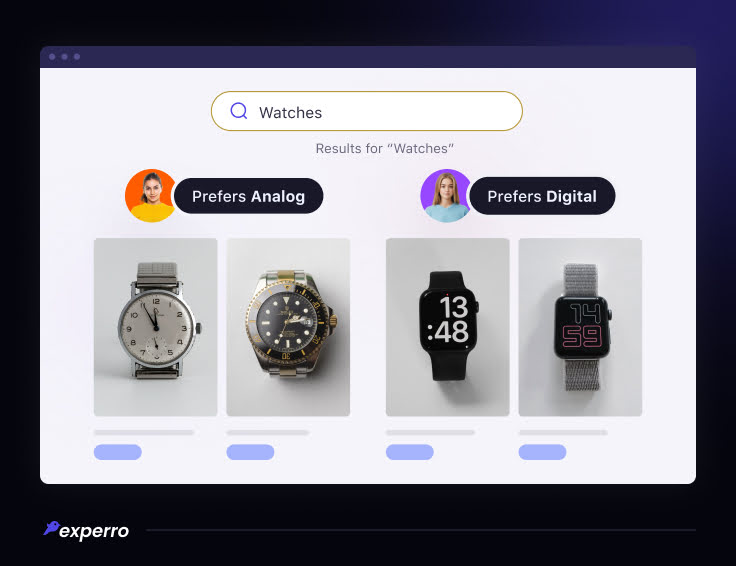
What are Digital Experience Platforms?
Digital Experience Platform Definition - A DXP is a cohesive set of technologies built to enable the composition, management, delivery, and optimization of contextualized digital experiences.
Unlike traditional CMS, which primarily focuses on web content management, DXPs provide a broader range of functionalities, including but not limited to web content, mobile apps, and portal solutions.
In the next section, we are revealing the best digital experience platforms that are leading the market currently.
What are the Best Digital Experience Platforms?
The list of top digital experience platforms is way too long to be listed in one single listicle. However, we have taken the popular Digital experience platforms to fulfil your knowledge thirst and the list is as follows:
1. Experro
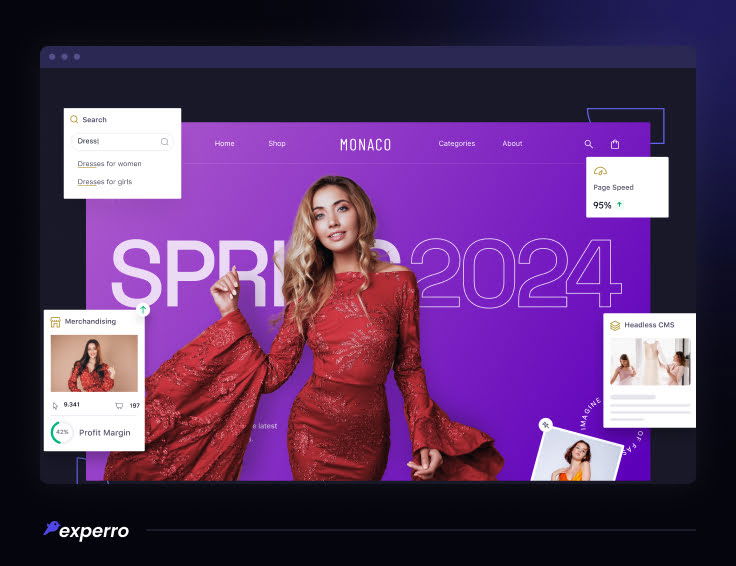
Experro is one of the best digital experience platforms (DXP) that comes packed with a headless CMS for delivering rapid, personalized, and memorable eCommerce experiences to all your visitors.
Experro's integrated Digital experience platform enables the distribution of relevant content across any digital channel.
Moreover, Experro serves as a centralized portal, facilitating interaction and cooperation across customer experience apps.
It is one of the top digital experience platform examples as this completely managed platform comprises a Headless CMS, drag and drop website Builder, and Artificial Intelligence search and merchandising.
Not only this, it is flexible platform, along with the upcoming marketing automation.
Even though Experro is an emerging DXP, it still provides customers with lightning-fast and engaging experiences, while marketing and eCommerce teams can employ no-code solutions to develop new on-demand digital experiences.
As a result, developers may focus on more important work rather than just complex technological stacks. Experro is a game-changing solution for building a lightning-fast website or a headless eCommerce store, showcasing why it stands out in the digital experience platforms market.
Features:
- Headless & Composable Frontend
- Headless CMS & API
- AI-Powered Product Discovery
- Visual Website Builder
- Centralized Content Hub
- AI-Powered Search
- Merchandising
- Headless Store Frontend
- A/B Testing
- Activity Dashboard
- Activity Tracking
- Alerts/Notifications
- Analytics
- Multiple Environments
- Search & Merch Insights
- Search APIs
- Personalized Search Optimization
- Versioning
Integrations:
Salesmate, Google Ads, Facebook Conversion, Segment.io, Salesforce, Zoho, Pipedrive, Azure, AWS, Google Cloud Platform, adForm and more...
Pros:
- Personalization
- Business-to-client relationship
- All-in-one Digital Experience Platform
- Customer management is easier
Cons:
- Couldn’t find any for now, but will update if found later
2. Adobe Digital Experience Platform
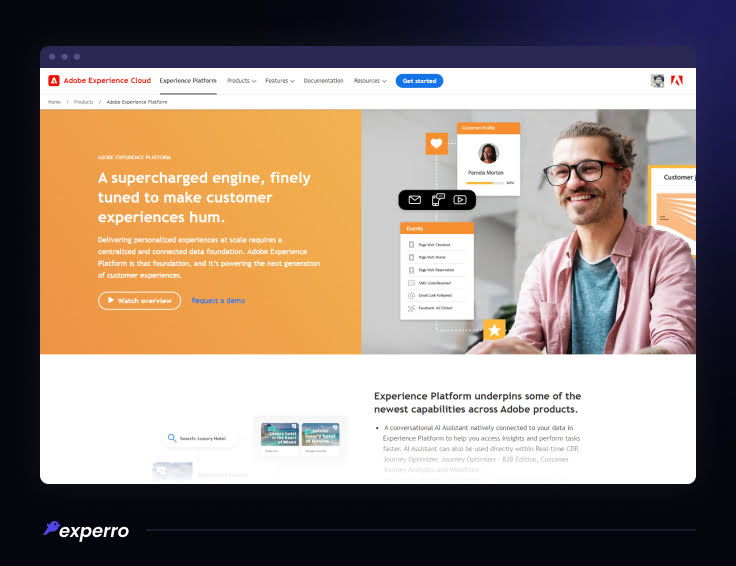
With unique technology that facilitates gathering, maintaining, and acting on consumer data across all existing and future apps available to date, Adobe Experience Platform is doing well among the top digital experience companies as it enables large-scale personalization.
In fact, Adobe's natively built-on Experience Platform applications provide best-in-class solutions for analytics, engagement, audience development, activation, omnichannel customer journey analysis, and optimization.
The open and flexible digital experience platform architecture, along with intelligent tools, services, and APIs, creates a one-of-a-kind environment in which options are available to develop custom applications that best suit your company's procedures.
Adobe Sensei, the platform's intelligent layer, is based on artificial intelligence (AI) to allow data-driven choices and highly tailored consumer experiences.
Features:
- Data collection
- Experience Data Model
- Real-time customer profile
- Data governance
- AI services
- Query service
- Privacy service
Integrations:
- Hootsuite, Contently, Relayto, Highspot, Censhare, Widen Collective, and many more.
Pros:
- It is incredibly expandable, and there are enough Java developers with experience in Adobe Digital Experience Platform out there for it to be a viable choice for business clients.
- Offers great digital experience platform capabilities.
Cons:
- Digital Assets Management is a little challenging to handle since it's not always simple to find the files you need in the appropriate location. To make things easier, users normally have to work with at least two tabs.
3. Acquia Digital Experience Platform
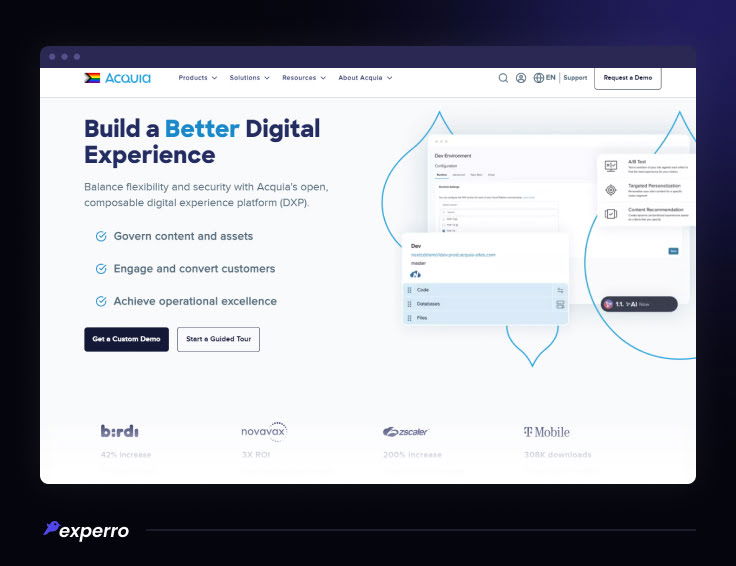
Acquia also falls amongst the best AI-based headless content management systems (CMS) that help firms manage and distribute marketing material across numerous digital channels, including customer portals.
Administrators in Acquia DXP can surely use the Drupal Cloud platform to create web pages with a drag-and-drop interface and options to add in-demand digital experience platform features.
All of this is in accordance with brand rules; moreover, they provide developers with role-based editing access for areas like customer portals.
Businesses may create development workflows, deploy code, and construct back-end or front-end apps using the integrated development environment (IDE).
Supervisors may use Acquia Marketing Cloud to design new sales campaigns and obtain a consolidated view of client groups, path mapping, instances, and other essential customer data.
Features:
- Drag & Drop Interface
- Component-Based
- Responsive Design
- Multilingual
- Multi-Experience Management
- Data Management
- Security & Compliance
- Digital experience management
- Multi-Marketing Automation
- Snowflake Data Sharing
Integrations:
- Facebook, Oracle Service Cloud, Oracle BlueKai, LiveRamp, Salesforce
Pros:
- Administering SSL certificates.
- Backing-up databases.
- Scheduling jobs.
Cons:
- Details on visitors and views are reported in the admin Interface.
- Improved transparency into database and file storage, as well as optimization of each is required.
- Monitoring and notification are missing.
4. ContentStack
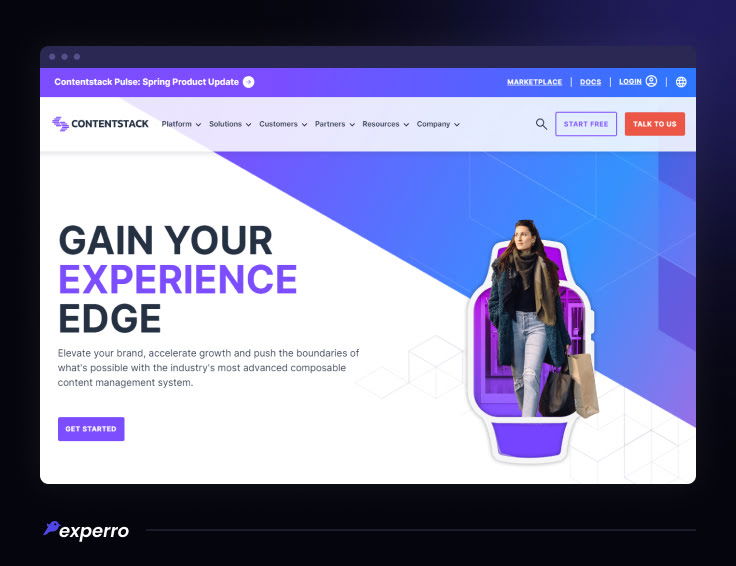
Contentstack is an API-first headless CMS which is also one of the best digital experience platform companies created primarily to enable organizations deliver tailored content experiences.
This is done to gain audiences over numerous channels, including but not limited to augmented or virtual reality platforms, mobile and web devices, as well as IOT (Internet of Things). It employs JSON architecture and CDN (Content Delivery Network) APIs to fulfill the activities listed above.
Administrators of this customer-centric digital experience platform may use Contentstack to modify or convert photos to fit their screen sizes and govern role-based access rights to create, update, delete, or publish relevant content online.
Supervisors may use Contentstack’s admin panel and built-in asset management to track changes or modifications done in the content versions, set up approval procedures, and manage media files.
Single sign-on (SSO), two-factor authentication, and 256-bit encryption are features of the digital experience management software that help enterprises safeguard data. Administrators may also localize content by configuring applicable languages across worldwide websites or apps.
It also lets you keep audit logs, plan content publication procedures, and upload data in bulk to the platform.
Features:
- Content Authoring
- Rich Text Editor
- Versioning
- Approval Process
- Content Scheduling
- Asset Management
- Internal Search
- Content Repository
- Customization
- SEO
- Flexible Navigation Structures
- User, Role, and Access Management
- Enterprise Scalability
- Internationalization
- API & Integrations
Integrations:
- MonkeyLearn, IBM Watson, Zapier, Memsource, XTM, Algolia, Bynder and more...
Pros:
- Excellent tools for picture manipulation, conversion, and compression.
- CMS platform that is smart, powerful, and dependable.
Cons:
- Lack of pre-built templates and libraries.
5. Vue Storefront
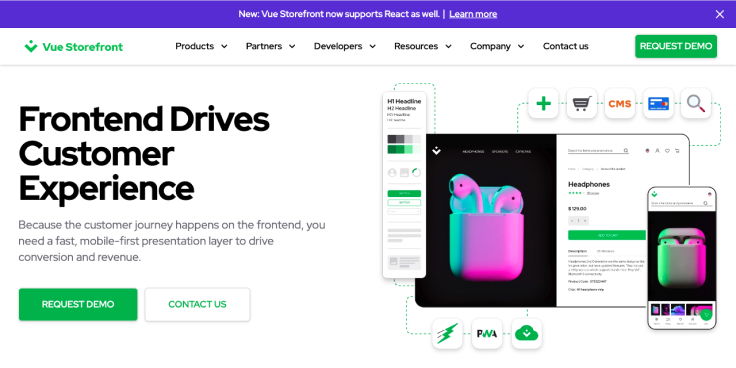
Vue Storefront is one of the digital experience platform vendors that offers standalone PWA storefront with front end for headless commerce.
It easily connects with other best-of-breed systems available within the client’s tech-stack through API (For e.g. Magento, Shopware and more). It allows you to build a progressive web app to create native shopping experiences.
Vue Storefront is one of the best eCommerce front-end platforms available for headless shopping. Vue Storefront enhances site performance and customization options while offering shopping experiences like those found in native applications.
It was developed using a PWA and headless commerce design strategy and a modern JS stack.
Building your eCommerce can almost take months but it just takes weeks when you work with Vue Storefront. Slow load times are reduced to fractions of a second with its fast-speed technology.
Moreover, clumsy consumer encounters with your brand online or offline are replaced by fluid ones.
Features:
- Push Notifications
- Offline Mode
- Magento-Ready Platform
- Third-Party Integrations
- Voice Commerce
- Cloud Hosting & Backups
- AMP Rendering Engine
- Chatbot Assistant
- PayPal Payments
- Full-Screen Mode
Integrations:
- PayPal, Amazon Alexa, and Google Assistant
Pros:
- PWA-ready and Headless
- Speed of navigation
Cons:
- Missing features akin to catalog rules or basket rules.
- Drop in traffic, conversions and page speed scores after switching.
What Are the Benefits of Digital Experience Platforms?

Discover the key advantages of digital experience platforms (DXP), essential tools in today's digital business landscape for enhancing customer engagement and streamlining digital operations.
1. Enhanced Customer Experience:
One of the primary benefits of DXP is their ability to provide a seamless and personalized customer experience across various digital touchpoints.
By leveraging customer data and analytics, DXPs enable businesses to tailor their content and interactions to meet the unique needs and preferences of each customer, thereby improving customer satisfaction and loyalty.
2. Consistent Omnichannel Presence:
DXPs allow organizations to maintain a consistent presence across multiple digital channels, including websites, mobile apps, social media, and more.
This consistency is crucial for building a strong brand identity and ensuring a cohesive user experience, regardless of how or where the customer interacts with the brand.
3. Improved Operational Efficiency:
By integrating various digital marketing tools and technologies into a single platform, DXPs can significantly streamline workflows and reduce the complexity of managing digital experiences.
This integration leads to improved efficiency and productivity, as teams can manage content, campaigns, and customer interactions more effectively.
4. Data-Driven Insights:
DXPs come equipped with robust analytics and data management tools that provide valuable insights into customer behavior, engagement, and preferences.
These insights enable businesses to make informed decisions, optimize their digital strategies, and deliver more effective and targeted marketing campaigns.
5. Scalability and Flexibility:
Digital Experience Platforms are designed to be scalable and flexible, accommodating the growing and changing needs of a business.
Whether it’s expanding to new markets, adding new digital channels, or integrating new technologies, DXPs can adapt and scale accordingly.
6. Enhanced Collaboration and Creativity:
DXPs often feature tools that facilitate collaboration among different teams, such as marketing, sales, and IT.
This collaborative environment not only improves workflow efficiency but also fosters creativity, as teams can work together more effectively to create innovative digital experiences.
7. Competitive Advantage:
In a digital landscape where customer expectations are constantly evolving, having a sophisticated DXP can provide a significant competitive advantage.
Organizations that leverage DXPs are better positioned to deliver cutting-edge digital experiences, stay ahead of customer trends, and differentiate themselves in the market.
The adoption of DXPs represents a strategic investment in improving overall business performance and customer engagement in the digital age.
What Types of Digital Experience Platforms (DXP) Exist?
Digital Experience Platforms (DXP) come in various types, each designed to cater to different business needs and digital strategies.
Understanding the types of DXPs available in the market helps organizations choose the right platform that aligns with their specific requirements. Here are the main types of Digital Experience Platforms:
1. Open Source DXPs:
These platforms, like the Liferay Digital Experience Platform, are built on open-source software, offering high levels of customization and flexibility.
Businesses can modify the source code to tailor the platform to their specific needs, making them a popular choice in the list of digital platforms.
2. Proprietary or Commercial DXPs:
Developed by digital experience platform companies, these are not open for modification by users. They often come with robust support and regular updates but can be less flexible than open-source solutions.
Adobe Experience Manager is a notable example in the category of best digital experience platforms.
3. Headless DXPs:
Headless DXPs like Experro separate the content management and delivery layers, allowing for greater flexibility in how and where content is displayed.
This type is ideal for businesses looking to deliver content across multiple digital channels, such as web, mobile apps, and IoT devices, and is a key player in the digital experience platforms dxp category.
4. Cloud-Based DXPs:
Hosted on the cloud, platforms like Salesforce Experience Cloud offer scalability, reliability, and reduced infrastructure costs.
They are ideal for businesses looking for quick deployment and minimal on-premise infrastructure, representing a significant segment of the digital experience platforms market.
5. Integrated DXPs:
These platforms offer a comprehensive suite of tools and applications integrated into a single platform. They typically include content management, e-commerce, analytics, and customer relationship management (CRM) functionalities.
SAP Customer Experience and Oracle CX are examples of integrated DXPs, often highlighted in Gartner digital experience platforms reports.
6. Specialized DXPs:
Some DXPs are tailored for specific industries or use cases, such as e-commerce, education, or healthcare. These platforms come with specialized features and functionalities that cater to the unique requirements of these sectors.
By understanding the types of Digital Experience Platforms available, organizations can make an informed decision that best fits their digital transformation goals and enhances their digital customer experience.
Key Features of the Best DXP Platforms
The best Digital Experience Platforms (DXP) distinguish themselves through a set of essential features that cater to the complex and evolving needs of modern businesses in the digital experience platforms market.
These features not only enhance the core functionality of the platforms but also provide significant value to organizations looking to optimize their digital presence.
Here are the popular digital experience platform features that make a DXP stand out in the market:
1. Robust Content Management:
A top-tier DXP offers advanced content management systems capabilities, enabling businesses to create, manage, and distribute content efficiently across various digital channels. This includes support for rich media, dynamic content, and content personalization.
2. Omnichannel Delivery:
The ability to deliver a consistent and seamless experience across multiple channels, including web, mobile apps, social media, and IoT devices, is crucial. A standout DXP ensures that content and services are optimized for each channel.
3. Personalization and Customer Experience Management:
Leading DXPs provide tools for creating highly personalized user experiences. They use data and analytics to tailor content and interactions based on user preferences, behavior, and history.
4. Integration and API Support:
A key feature of the best DXPs is their ability to integrate with various third-party systems and applications, such as CRM, ERP, and marketing automation tools, through robust APIs and connectors.
5. Scalability and Performance:
Top DXP for small businesses are designed to scale with the growth of a business, handling increased traffic and content without compromising on performance.
6. User Experience and Interface Design:
A user-friendly interface for both end-users and administrators is essential. The best DXPs provide intuitive design and navigation, enhancing the overall user experience.
7. Advanced Analytics and Reporting:
Comprehensive analytics and reporting capabilities are crucial for understanding user behavior, measuring the effectiveness of digital strategies, and making data-driven decisions.
8. Security and Compliance:
With increasing concerns about data privacy and security, top DXPs prioritize robust security features and compliance with global data protection regulations.
9. Customer Support and Community:
Strong customer support, including training, documentation, and an active user community, is a hallmark of the best digital experience platforms, ensuring that users can maximize the platform's capabilities.
10. AI and Machine Learning Capabilities:
The integration of AI and machine learning technologies for advanced features like predictive customer analytics, content recommendations, and automated customer service is a standout feature in leading DXPs.
These features collectively contribute to the effectiveness of a Digital experience platform, enabling businesses to deliver exceptional digital experiences, drive engagement, and achieve their digital transformation goals.
How to Choose a Digital Experience Platform (DXP)?
Choosing the right Digital Experience Platform (DXP) is crucial for businesses looking to enhance their digital strategy and customer engagement.
The selection process involves considering various factors to ensure the platform aligns with specific business needs and goals. Here's a guide to help in selecting the appropriate DXP:
1. Assess Your Business Needs:
Begin by evaluating your business objectives, target audience, and the type of digital experiences you want to create. Consider the specific challenges you face in your current digital marketing strategy and what you aim to achieve with a DXP.
2. Understand the Features and Capabilities:
Research the features and capabilities of different DXPs. Look for key functionalities like content management systems, personalization, omnichannel delivery, integration capabilities, analytics, and AI-driven tools. Ensure the platform can support your current and future digital initiatives.
3. Integration with Existing Systems:
Check how well the DXP can integrate with your existing systems, such as CRM, ERP, and marketing automation tools. Seamless integration is crucial for a unified digital customer experience and operational efficiency.
4. Scalability and Flexibility:
Consider the scalability of the platform. It should be able to grow with your business and adapt to changing digital experience platform trends and customer expectations. Flexibility in customization is also important to tailor the platform to your specific needs.
5. User Experience and Ease of Use:
Evaluate the user experience of the platform for both your team and your end-users. A user-friendly interface and ease of use are important for efficient management and adoption of the platform.
6. Security and Compliance:
Ensure the DXP adheres to industry-standard security protocols and complies with relevant data protection regulations. This is crucial to protect customer data and maintain trust.
7. Vendor Reputation and Support:
Research the vendor's reputation in the digital experience platforms market. Look for reviews, case studies, and testimonials. Consider the level of support and training the vendor provides to help you make the most of their platform.
8. Cost Considerations:
Analyze the total cost of ownership, including licensing fees, implementation costs, and ongoing maintenance. Ensure the investment aligns with your budget and offers a good return on investment.
9. Request Demos:
Before making a decision, request demos or trials to get a hands-on experience with the platform. This will help you understand if the platform meets your expectations and is the right fit for your business.
10. Evaluate the Ecosystem:
Consider the ecosystem surrounding the DXP, including third-party plugins, extensions, and the developer community. A robust ecosystem can provide additional functionalities and support.
By carefully considering these factors, businesses can choose a DXP that not only meets their current needs but also supports their long-term digital experience strategy.
Conclusion
In the rapidly evolving digital landscape, the significance of digital experience platforms (DXP) cannot be overstated. As businesses strive to meet the ever-changing demands of the digital era, DXPs emerge as essential tools, offering a blend of innovation, efficiency, and customer-centricity.
From enhancing customer experiences through personalized content to streamlining operations with integrated systems, DXPs are redefining how businesses interact with their audience across multiple digital touchpoints.
Whether it's through open-source flexibility, headless CMS capabilities, or AI-driven personalization, these platforms are at the forefront of digital transformation.
As we've explored the various types, key features, and strategies for choosing the right DXP, it's clear that investing in a robust DXP is not just a step towards enhancing digital presence; it's a leap towards future-proofing your business in an increasingly digital world.
Stay tuned for more such blogs! Contact us for your DXP-related enquiries.
FAQs


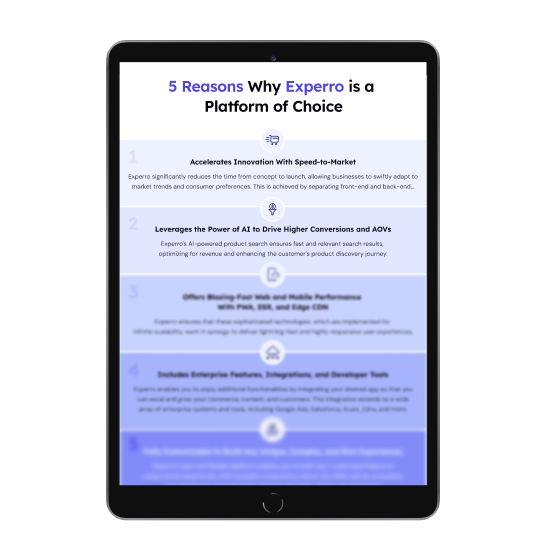
Ekta Ganwani
12 December 2024With a sharp knowledge of SEO and SERP, Ekta's research is her strength. She is a meticulous researcher with an eagle eye for finding errors and ensuring on-page content is top-notch. When not working, Ekta can be found binging the latest Netflix series or meditating to find her inner zen.